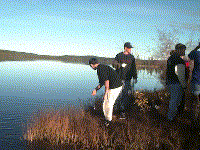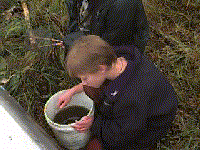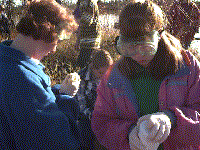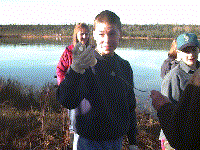



We are located in southcentral, Alaska, in the Copper River Basin. We are studying the two lakes, one has a lodge and 13 or so year round residents, and the other has no residents. Our lake is located 17 miles west of Glennallen, AK (146 5' W, 62 8' N). Glennalen is 114 miles north of Valdez, AK and 187 miles east of Anchorage, AK.

The Seventh Grade class had fun this past Monday exploring the ecosystem of Tolsona and Moose lakes. The weather was overcast and foggy in the morning, but as the day progressed the fog lifted and the skies began to clear.
As part of an on going study the students gathered observational data at both lakes. This included plant life in and around the lake, mud depth in the lake, temperature of the lake and weather data. Much of the time was spent gathering aquatic insects from the outlet creek of each lake. The students will be comparing the different types of feeding functional groups in the two creeks. If you want to know more about the trip or about feeding functional groups, ask a seventh grader.

On Tuesday September 26th the 8th grade traveled to Tolsona and Moose lakes. They were there to investigate the chemical and physical characteristics of the lakes, the changes that take place, and how these characteristics effect other organisms that use the lakes.
The weather was nice and sunny most of time, except in the morning when it was a little chilly. The trail was wet and muddy through out most of the day.
There were two sites at each lake. The groups took samples and tests throughout the day. The tests that were done consisted of temperature, dissolved oxygen, pH, and nitrates. The samples that were taken were brought back to the school and used for fecal coliform testing and total phosphorus.
Mr. Szarzi assembled film crew and reporters. The film crew took pictures of the testing being done. The reporters took notes and quotes from the different groups.
Some of the kids gave quotes. Most of them were similar in
content. People said, "This is better than school." Others had original
ones such as; "It's a crustacean that's gross!" or "It's fun we get to play
with mud," or "I can't wait to go back in the spring." "I'm wet!" was
another quote. Overall the class enjoyed the trip.

The eighth grade students have finished their data analysis and their final reports from this fall's sampling. The following is a compilation of the student's reports:
Moose Lake is a young lake in a remote area, there is only one house around the lake. The students observed swans and beavers that live on the lake as well as a large diversity of aquatic bugs. There were some miscellaneous items around the lake. There was a small bridge, a broken dock, some old tires in the water, and other things scattered along the bank. Lilly pads and other vegetation surround the lake.
Tolsona Lake has a larger human population than Moose Lake, but both of the lakes are relatively young. Tolsona Lake has 13 houses around it, a lodge, and it is fairly close to the main road. There is an abundance of tall grasses and other types of vegetation. There is also an island in the middle of the lake.
Water quality testing is a process used to see if there is anything wrong with the water, for instance if it is polluted. We performed eight tests to find the water quality. The tests include: dissolved oxygen (DO), pH, turbidity, nitrates, biological oxygen demand (BOD), fecal coliform, phosphorus and total dissolved solids (TDS).
Water temperature, BOD, and percent saturation of oxygen were graphed to show the differences between the two lakes. (see our data for 8/26/95)
There is a differences in TDS and fecal coliform. The TDS at T1 was .78 mg/100ml, at T2 it was .09 mg/100ml, at M1 it was .1 mg/100 ml, and at M2 it was .08 mg/100 ml. Fecal coliform in 100ml at T1 it had 50 colonies, at T2 it was 1colony, the other two didn't have any colonies. No differences were found in phosphorus, pH, nitrates or air temperature.
Fecal Coliform
Fecal coliform was higher at Tolsona Lake site 1 (T1) than at any
other site because there is more human development at T1 than at any other
of the sites. It also may be associated with sewage leaking or getting
into the water from the human development.
BOD
The BOD was higher in Moose Lake sites 1 (M1) and 2 (M2), possibly because there is more vegetation in the Moose Lake compared to the Tolsona Lake, that is being broken down or eaten by the organisms that use the oxygen.
Percent Saturation of Oxygen
The differences in percent saturation of oxygen can be attributed
to human error or differences in the testing procedure. But the results do
indicate a healthy level.
TDS was the highest T1 mostly because of human development. The boats and people stirring up the water and sediment probably effected the water sample.